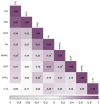Diagnostic accuracy of bone-related biomarkers on peri-implantitis: potential of A-proliferation-inducing ligand
- PMID: 40713636
- PMCID: PMC12297803
- DOI: 10.1186/s12903-025-06578-y
Diagnostic accuracy of bone-related biomarkers on peri-implantitis: potential of A-proliferation-inducing ligand
Abstract
Objective: To study the biomarker profile in peri-implant crevicular fluid (PICF) of A proliferation-inducing ligand (APRIL), receptor activator of nuclear factor κβ (RANKL) and interleukin (IL)-23, in healthy, periimplant mucositis and peri-implantitis sites, and to explore their diagnostic accuracy on periimplantitis (PI) diagnosis.
Materials and methods: An exploratory cross-sectional study was conducted. Sociodemographic and clinical were recorded. Implant diagnosis was made based on the latest classification consensus. PICF samples were collected with paper strips from healthy, mucositis and PI implants. The biomarkers were analyzed by Luminex assay. The diagnostic accuracy was determined through sensitivity, specificity, predictive values (PV), and receiver operating characteristic (ROC) curves.
Results: Overall, 54 patients were recruited; 17 were healthy implants, 19 with mucositis and 18 have PI. RANKL and APRIL levels in PICF were significantly increased in PI implants compared to healthy implants (p < 0.001 and p = 0.005). IL-23 did not present differences between groups (p > 0.05). Positive correlations between PICF-RANKL levels and clinical attachment loss, plaque index score and bleeding on probing were observed (rho = 0.33; rho = 0.35; rho = 0.33; p < 0.05, respectively). Additionally, PICF-IL-23 and APRIL were correlated with the plaque index score and peri-implant probing depth (rho = 0.28; rho = 0.28, p < 0.05). PICF-APRIL concentrations and plaque index score were associated with PI (OR:3.01; 95%CI [1.08-8.38], p = 0.035, and OR:11.24; 95% CI [2.63-48.16], p = 0.001, respectively). The regression model, which included PICF-APRIL and plaque index, showed an AUC-ROC of 0.95, a sensitivity of 94.4%, 83.3% specificity, a positive PV of 73.9%, and a negative PV of 96.8%.
Conclusions: Implants with PI have higher levels of APRIL and RANKL in PICF compared to healthy implants. The model that includes the levels of APRIL in PICF combined with the plaque index score leads to an enhanced accuracy of PI diagnosis.
Clinical relevance: Clinical diagnosis of peri-implant disease can be improved with molecular tools, in this case, APRIL demonstrated high accuracy for the diagnosis of PI.
Keywords: Biomarkers; Molecular diagnosis; Peri-implant crevicular fluid; Peri-implantitis.
© 2025. The Author(s).
Conflict of interest statement
Declarations. Ethics approval and consent to participate: The Ethical Committee boards of the Universidad de la Frontera approved the study (#ID0242018). Detailed explanation of the project and a written informed consent was given and obtained from all study participants. The present research was conducted in compliance with the Helsinki declaration of 1973, amended in 2024. Consent for publication: Not applicable. Competing interests: The authors declare no competing interests.
Figures



References
-
- Schwarz F, Derks J, Monje A, Wang HL. Peri-implantitis. J Periodontol Jun. 2018;89(Suppl 1):S267–90. 10.1002/jper.16-0350. - PubMed
-
- Berglundh T, Armitage G, Araujo MG, Avila-Ortiz G, Blanco J, Camargo PM, Chen S, Cochran D, Derks J, Figuero E, Hämmerle CHF, Heitz-Mayfield LJA, Huynh-Ba G, Iacono V, Koo KT, Lambert F, McCauley L, Quirynen M, Renvert S, Salvi GE, Schwarz F, Tarnow D, Tomasi C, Wang HL, Zitzmann N. Peri-implant diseases and conditions: consensus report of workgroup 4 of the 2017 world workshop on the classification of periodontal and Peri-Implant diseases and conditions. J Periodontol. 2018;89(Suppl 1):S313–8. 10.1002/JPER.17-0739. - PubMed
-
- Derks J, Tomasi C. Peri-implant health and disease. A systematic review of current epidemiology. J Clin Periodontol Apr. 2015;42(Suppl 16):S158–71. 10.1111/jcpe.12334. - PubMed
-
- Carcuac O, Abrahamsson I, Albouy JP, Linder E, Larsson L, Berglundh T. Experimental periodontitis and peri-implantitis in dogs. Clinical Oral Implants Research Apr. 2013;24(4):363–71. 10.1111/clr.12067. - PubMed
MeSH terms
Substances
Grants and funding
LinkOut - more resources
Full Text Sources
Research Materials
Miscellaneous

